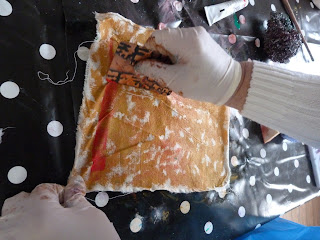We experimented with wet and dry fabric-wet your fabric with water in a spray dispenser ( like one that you use to mist plants).
The techniques included:
- painting various shapes with a brush,
- dabbing with a brush,
- using the edge of the brush
- rag rolling,
- using sponges,
- scrunching a baby wipe, dip in paint then wipe onto fabric,
- using a toothbrush to spatter paint,
- dabbing glue onto fabric then using watery paint on top, scraping paint with a flat surface e.g old credit card.
- experimenting with spray paints
- holding a lit candle above the fabric to drip wax onto it, use watery paint onto top of the wax, iron off with brown paper when paint is dry.
- flick paint
- dribble paint
When you have finished your session use a piece of fabric to wipe all the excess paint from your paint container and any spillages. This can also be used. Remember, never throw anything away, fabrics can be recycled at a later date.
Record your methods of experimentation by writing on a sticky label - this is useful for future reference to remind you about your techniques.
Keep wet warm colours (red, orange, yellow) separate from cold colours (blues green, cold purple) when painting or you will end up with dirty greys and browns. (Unless you want these colours)
It is wise to invest in a colour wheel or look on the internet about the colour wheel and how it works.
These samples will be used at a later date to print onto and sewn into.
Rag rolling above
Flicking paint on the right.
Scraping paint above.
Dabbing paint on the right.
Once the students had finished they looked at their work and reflected on their process. They thought and talked about the following:
Which colours am I drawn to?
Which of the techniques did I like?
Which technique did I start/end with?
How did I feel at the beginning of the session and at the end?
How does it feel to use techniques without knowing or planning the outcome?
Students noticed that they did have preferences for certain colours and techniques-everyone was different and even at this early stage students are developing their own style. There are no wrong ways to create things. Have a go then reflect on the piece of work, this way you will learn more about yourself and your process of making. Use sentences like " I notice......" Try to see your art making as something that you are learning and like anything else you will need lots of positive encouragement so make sure that you praise yourself for having a go and silence your inner negative voice.
The students noticed that the more time they spent playing and experimenting with techniques the more they relaxed. If you are doing this at home give yourself at least 2 hour slot to set up (cover your work area with newspapers so that you're not worried about colour going everywhere. Then have a long period of working with time to clear away.
Last tip-if you ever feel that you are getting stressed in any creative activity then stop and stretch your body or go for a short walk or dance- then come back to your work.






No comments:
Post a Comment